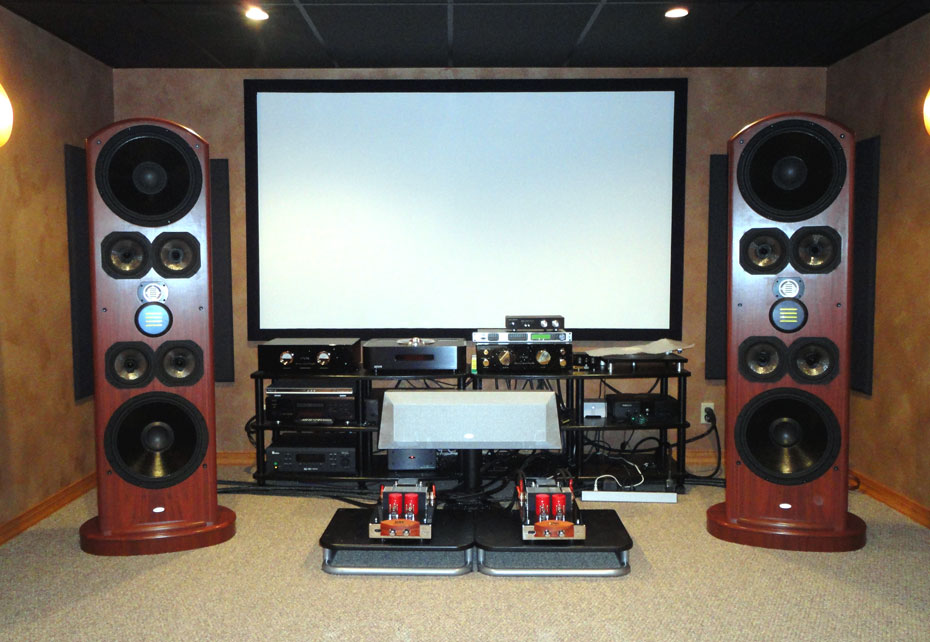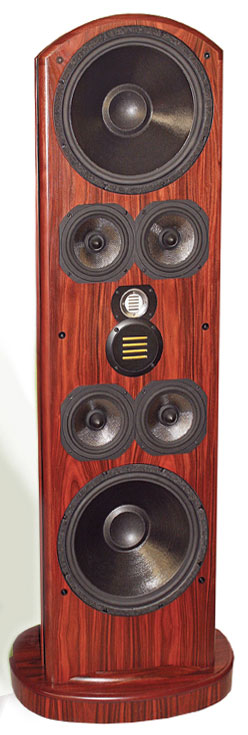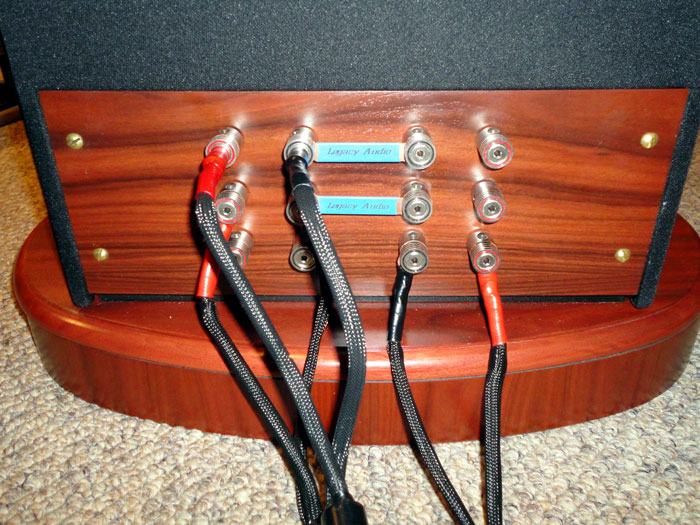The Making of An Outlier Speaker
The DSW brings three ideal conditions to one design – Build Quality, Driver Selection and Configuration, and an Active Crossover. Though some may disagree with the selection of internal wiring or the tension clips used to connect leads, the execution of the assembly is expertly. If the criterion for “good enough” in terms of the quality of the components and build of a speaker is one threshold to reach, the DSW easily passes that test.
Bill makes much of the driver configuration, especially piston area, or aggregate size of the cones interacting with the air. I also feel this is a “make or break” proposition in determining upper echelon speakers. Simply put, the vast majority of smallish floor standing speakers are terribly compromised in terms of capacity to produce a sizable soundstage with generous dynamic power. No amount of finagling can change that. The DSW, as with all Whispers, has the capacity to stun due to its generously appointed driver set. It can play big and loud without distortion, and do so while sounding intricate. The particular set of drivers used including the ultra-light and fast bass drivers, the quad of 7-inch mid-bass, and the planar mid and ribbon high drivers capture a splendid set of positive attributes which together sound terrific.
Not the least of the three critical criteria for the DSW as an outlier speaker is the ability to operate with an active crossover. Bill places a high degree of emphasis on the quality of the processor, the Xilica 4080, used in crafting the filters in the active crossover. It is an upgraded version of the unit used in the Helix that I reviewed. This newer version is a 40-bit processor with filters which, according to Bill, “…settle to zero in a finite number of cycles. Conventional filters, active or passive never fully settle.” Recalling the noise floor of the Helix with the older design processor, the DSW is substantially quieter. The new processor also has up to 55 dB of gain, allowing for a larger level-matching range between preamp and amp. This feature is useful to assist lower gain preamps with amplifiers demanding higher gain.
Before exploring the DSW, I placed very little importance on the role of an active crossover, thinking that a passively crossed speaker could perform quite closely to an active. The Helix was so radically different in scale and performance that I was unable to conclude that the preponderance of its superiority was linked to the use of the outboard crossover. Through direct testing of the DSW in both passive and active crossover modes, my opinion has changed such that I now think the active crossover is of paramount importance. Let’s see how I arrived at that conclusion.
Three Sets of Speakers In One
The DSW is configurable in three distinct ways:
A. Two to four channels of amps hooked up directly to the speaker, namely stereo, passive Bi-amping or Tri-amping, sans processor, using only the speaker’s internal passive crossovers. When operating the speakers with four channels of amplification I used Audioquest’s RCA 1-to-2 splitters at the preamp.
B. Two to six channels of amplification through the external, active crossover to tailor the sound to your taste; or you can mix amps, i.e. solid-state on the bass and tube on the mid/treble.
C. Hybrid configuration through the processor, with one set of signals actively managed for the bass, and another set of signals passed through unadulterated to the speaker’s internal passive crossovers for the midrange and treble.
There is potential for a much larger number of setup options with the DSW than a traditional speaker. Legacy Audio can also send a trained tech to set up the DSW so you don’t have to give it a moment’s concern. Conversely, if so desired they can give you full access to the processor software so you can control the processor’s filters, commanding each driver set. For further discussion of basics involving the use of the processor please see my review of the Legacy Audio Helix speaker system.
The Hardware
The outline of the Whisper in any version vaguely resembles an enormous wooden fudgesicle with an oval base. (Right on! –Ed.) The eye beholds the bespoke quality woodwork; my set was Rosewood, but black Oak, Cherry, Curly Maple and Walnut can be ordered. In each speaker, two pairs of huge piggy-backed Xtreme 15-inch woofers flank the quad of mid-bass drivers, which in turn surround the 4-inch planar midrange and 1” neo-ribbon tweeter. It’s an interesting visual pastiche as the bass drivers are black doped paper, the mid-bass cones shimmer with woven silver elements, the midrange has a Post-it ™ note yellow hue, and the neo-ribbon tweeter seems like a metallic part from a 1950’s toy robot. The bulky front grill hides all these but protrudes from the cabinet face several inches, an accommodation to sonics rather than appearance. I removed the front grills for all listening.
The back of the speaker shows the 15-inch bass drivers to be open baffle design, but all remaining drivers are encased in their own sealed, poly-fiber filled cabinet. At the rear of that cabinet is a 12-inch back-firing counter-phase bass driver, designed to diminish head wall reflections from the backwaves of the bass drivers. Another sculpted grill covers all this, which I left on so as to ameliorate effects from front wall reflections.
The rear grills are held very tightly to the cabinet, so much so that after inspecting one as I slid it back in, the grill material caught on the rear baffle’s edge along a 2-3-inch section and puckered. This was the only material defect I encountered in use of the DSW, and had I been a bit more patient in replacing the grill I likely would have avoided this mishap. Upon my mentioning the issue I was sent a fix-it kit within 48 hours. A curious, quick drying tacky glue allowed me to restore the grill in about ten minutes. I suggest that Legacy wrap the grill material around the framework as opposed to cutting and gluing it down along the grill frame’s edge as this would eliminate the possibility of the baffle snagging the material.
Making A Connection
As aforesaid there are twelve binding posts on the lower back of the speaker, grouped in two sets of six. The active crossover requires use of the right set solely, and the speaker’s internal crossover utilizes only the left set. Both sets are arranged from top to bottom as TREBLE, MIDRANGE and BASS in a mirror image configuration with all negative posts occupying the inside positions. This is out of necessity; Legacy’s supplied copper jumper straps are placed on the sets of negative posts for channels utilizing the speaker’s internal crossovers. When bi-amping the Right set of bass posts are used, and the Left set of TREBLE and MIDRANGE posts are utilized along with their respective jumpers.
Legacy supplies a set of “Y” balanced interconnects which are used from the source or preamp to the processor’s four inputs. An additional pair of XLR interconnects for the processor for use when the speaker is in active crossover mode and speaker cables are required for each pair of amplifier channels used to power the speakers. As an example, to operate the speaker in Tri-amp active crossover mode requires three sets of XLR interconnects and three discreet sets of speaker cables. Note that the processor only accommodates balanced (XLR) cabling, so any amplifier used with the DSW must accept XLR inputs. RCA interconnects may be used only when the processor is not being used with the speaker.
Once the concept involved in use of an active crossover is understood – splitting the signal before it reaches the amp channels rather than after them – setups of such systems are much less daunting than anticipated. A useful diagram in the Owner’s Manual illustrates the positioning of speaker cables and jumpers for all three modes. However, the owner is left to deduce the arrangement of interconnects. This seems straightforward enough to experienced system builders, but could be a quagmire for those less technically inclined. Legacy needs to include in their illustrations straight through system diagrams of all connections for all three modes. Granted, as a reviewer who had discussed the operation of the speaker at length with Legacy as it was being designed, and the speaker being the first production model, my version of the Manual was likely streamlined. The final copy will likely make all connections obvious.
- (Page 1 of 3)
- Next page →



